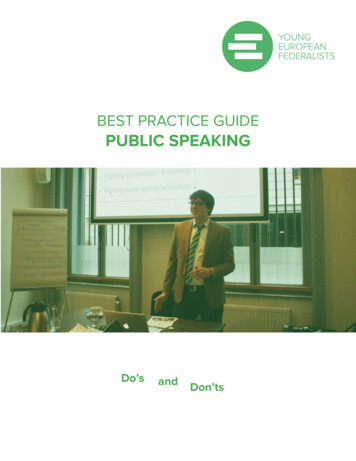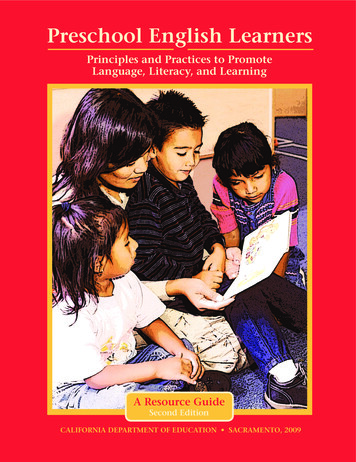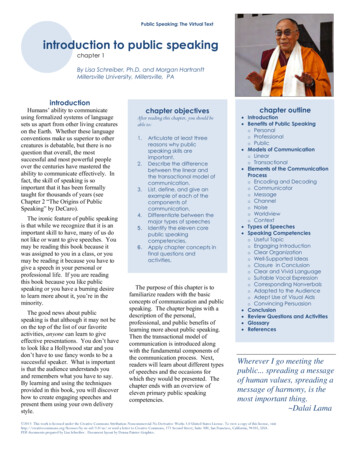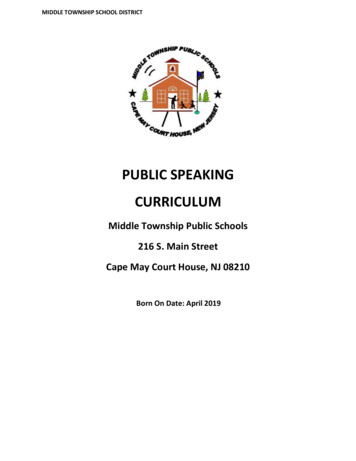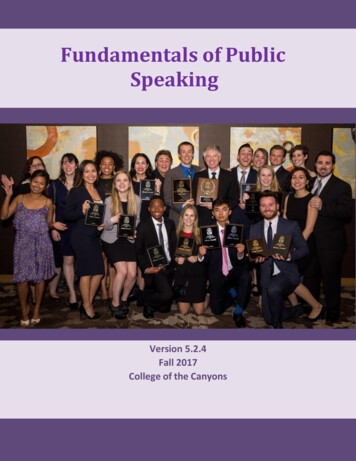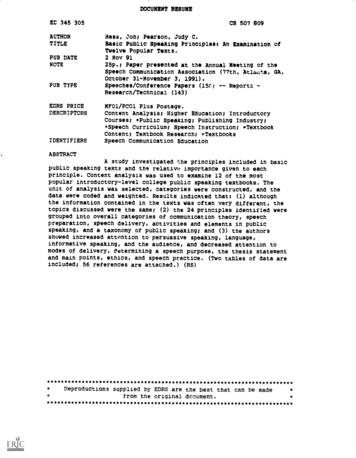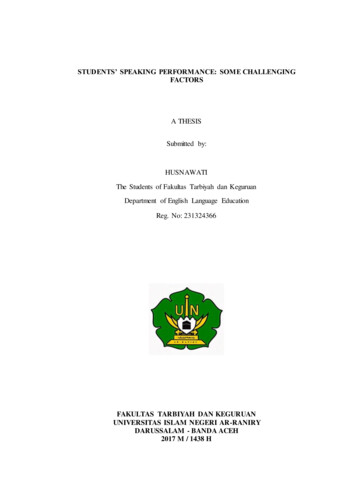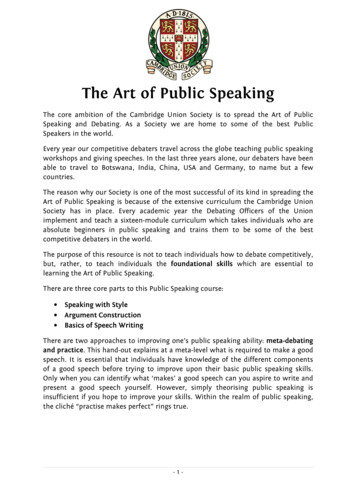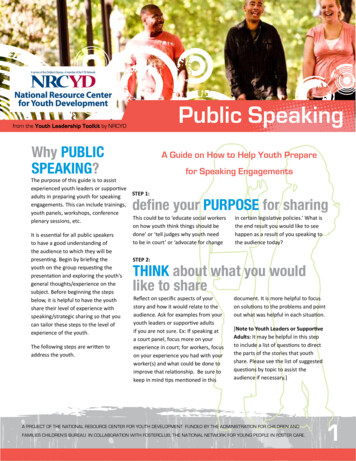
Transcription
A service of the Children’s Bureau A member of the T/TA NetworkPublic Speakingfrom the Youth Leadership Toolkit by NRCYDWhy PUBLICSPEAKING?A Guide on How to Help Youth Preparefor Speaking EngagementsThe purpose of this guide is to assistexperienced youth leaders or supportiveSTEP 1:adults in preparing youth for speakingengagements. This can include trainings,youth panels, workshops, conferenceThis could be to ‘educate social workersplenary sessions, etc.on how youth think things should bedone’ or ‘tell judges why youth needIt is essential for all public speakersto be in court’ or ‘advocate for changeto have a good understanding ofdefine your PURPOSE for sharingthe audience to which they will bepresenting. Begin by briefing theyouth on the group requesting thepresentation and exploring the youth’sgeneral thoughts/experience on thesubject. Before beginning the stepsbelow, it is helpful to have the youthshare their level of experience withspeaking/strategic sharing so that youcan tailor these steps to the level ofexperience of the youth.The following steps are written toaddress the youth.in certain legislative policies.’ What isthe end result you would like to seehappen as a result of you speaking tothe audience today?STEP 2:THINK about what you wouldlike to shareReflect on specific aspects of yourstory and how it would relate to theaudience. Ask for examples from youryouth leaders or supportive adultsif you are not sure. Ex: If speaking ata court panel, focus more on yourexperience in court; for workers, focuson your experience you had with yourworker(s) and what could be done toimprove that relationship. Be sure tokeep in mind tips mentioned in thisdocument. It is more helpful to focuson solutions to the problems and pointout what was helpful in each situation.[Note to Youth Leaders or SupportiveAdults: It may be helpful in this stepto include a list of questions to directthe parts of the stories that youthshare. Please see the list of suggestedquestions by topic to assist theaudience if necessary.]A PROJECT OF THE NATIONAL RESOURCE CENTER FOR YOUTH DEVELOPMENT, FUNDED BY THE ADMINISTRATION FOR CHILDREN ANDFAMILIES CHILDREN’S BUREAU, IN COLLABORATION WITH FOSTERCLUB, THE NATIONAL NETWORK FOR YOUNG PEOPLE IN FOSTER CARE.1
STEP 3:WRITE it downas you would like to say it. This helps toprepare for the overall direction you wantyour speech to take. You don’t need toread it during the presentation, in fact itis suggested to only take an index card oran outline with key points of your speechto help jog your memory if you slip up. Asyou do more speaking engagements, youwill learn what approach you are mostcomfortable with.It is important toSTEP 4:remember that thepurpose of speakingengagements isnot for individualtherapy. Youth shouldunderstand that thepurpose of a speakingevent is not the time toprocess their emotions.This should not beSHARE itwith your youth leadership group as ifyou were sharing with your audience.If there is more than one speaker, thiswill help to ensure there is little overlapon stories and you can focus on uniqueexperiences, which will more effectivelyeducate the audience. Sharing helpsto make sure you stay in your allottedtime frame. Also, emotions can comeup during speaking, especially if it is anarea of your story that you have notspoken much about before or if thereare currently things going on with thatpart of your story. Sharing with yourgroup will allow you to work out thesefeelings in a safe environment prior tospeaking.If and when you get to a point in yourstory where you can feel emotionscoming up that you haven’t preparedfor, you can simply say “that’s all Iwould like to share at this point” andthen be sure to talk to a trusted adultabout this and the next part of yourstory after the speaking engagementis over. Once you have processed thiswith your supportive adult, you willbe able to share these ‘new’ parts ofyour story during your next speakingengagement which can lead to being aneven more effective youth speaker.done on stage, butrather with a trustedadult or counselorafter the speakingengagement is over.A PROJECT OF THE NATIONAL RESOURCE CENTER FOR YOUTH DEVELOPMENT, FUNDED BY THE ADMINISTRATION FOR CHILDREN ANDFAMILIES CHILDREN’S BUREAU, IN COLLABORATION WITH FOSTERCLUB, THE NATIONAL NETWORK FOR YOUNG PEOPLE IN FOSTER CARE.2
STEP 5:GO FOR IT!Here’s your time to deliver. For some people itis helpful to have an outline of points you wantto make; others prefer to keep the entire thingwritten out. Keep in mind: It doesn’t have tobe perfect! If you lose your place, no worries.Most audience members simply appreciate yousharing your views. Just take a moment to findyour place and pick up where you left off.TIPS FOR YOUTH PANELS The main job of the facilitator is to ensure the most relevantinformation gets out to the audience so that they can walkout not only being inspired, but more educated on how tobest serve other youth. If you only have a short time, Question and Answer (Q&A)portions are the most effective to help direct learning.Sometimes speakers will feel the need to speak on aparticular part of their story that may not necessarily berelevant because they want to be heard. It is important tovalidate that the youth needs to share that information, butalways try to bring the focus back to the topic at hand as thiscan detract from the message that the group is trying to getacross. If this does happen during a presentation, the youthshould be positively redirected during the debriefing andencouraged to speak with a trusted adult about that part oftheir story. Everyone on the panel does not need to answer everyquestion. Always remember the purpose of the panel is toeducate. You may have a part of your story that is relevant tothe question asked, but you should get a turn to speak. If it’snot adding new information, provide your unique experienceto another question. It is also important to educate youth on self awareness. Forexample some youth may desire to advocate for adoption,or post custody services, or even prevention services. It isgood for youth to know what their own agenda is and whenit is appropriate to share that desire as well as differencesbetween their own story and the collective story seenthrough statistics. A good way to address this is to mentionthe part of the youth’s story that is relevant, but then followup with a comment regarding what generally occurs. Forexample, “I was fortunate enough to have one home, thoughI know that’s not the case for most youth” or “I very muchknew that I wanted to be adopted at age 13 and wantedTPR (Termination of Parental Rights) done on my caseimmediately; however, this is not what all youth would wantand it is important to ask each youth on a case by case basis.”Here are some helpful tips to remember duringthe presentation:·Keep track of time. Know ahead of timehow much of the presentation should beallotted for question and answers and whenyou have five minutes left.·Smile and breathe. It’s okay to benervous. Public speaking is feared by mostAmericans, and you’re not only up in frontof people, you’re sharing your life story.Pause and take a deep breath occasionallyif you need to. It sounds a little silly, but itworks!STEP 6:DEBRIEF itafter the speaking engagement. Discuss withyour peers and supportive adults on whateveryone thought went well, and what couldbe improved for next time. If there were anyareas that brought up unresolved emotions,be sure to get with a trusted adult to workthrough these.A PROJECT OF THE NATIONAL RESOURCE CENTER FOR YOUTH DEVELOPMENT, FUNDED BY THE ADMINISTRATION FOR CHILDREN ANDFAMILIES CHILDREN’S BUREAU, IN COLLABORATION WITH FOSTERCLUB, THE NATIONAL NETWORK FOR YOUNG PEOPLE IN FOSTER CARE.3
List of suggested questions byaudience in developing an outline for speaking engagements:General questions·How long have you been in care? How old were youwhen you came in? Are you still in care? How old whenyou aged out?Community· Were there/are there people in your community that areimportant to you?· Are you/were you involved with social clubs in yourcommunity? Ex: boys and girls club, YMCA, arts centers,sports leagues, churches, jobs, etc? What impact didthey have on your life?·How many placements were you in? Schools? Did yousee brothers and sisters? Were you placed with them?· What connections did you have before you were takeninto care that you wish you would have been able tokeep after going into care?·What has been the best thing about being in foster care?The worst?· Why is it important that your relationship with thesepeople and places be maintained?Court·Did you have a guardian ad litem (GAL) or volunteer?How often did you meet with that person? Did you havean attorney? Did you know what their role was in yourcase? Did you have a CASA?·Do you know what a court hearing is? Do you know thatyou had a court hearing in your case? Did anyone tell youabout them? Who?·Did you ever attend your court hearings? Did you speakin court? Did you ever speak with or write to the judge?·Did you feel like anyone asked you what you wantedto happen in your case? Where you wanted to live?Whether you wanted to see your parents/siblings?Workers·How many workers did you have during your case? Didyou have regular contact with them?·What were some characteristics of your worker that youappreciated? What did they do that was helpful to you?·What would you like workers to know about youth?What advice would you give to a worker who wants tolearn how to better work with youth?Youth·What does being a youth leader mean to you?·Describe a time when you advocated for yourself orsomeone else. What was that like?·Who was a supportive person in your life and why?· What was your experience with foster parents? Howmany/what type of placements?·Describe a time that you had a struggle in care and whatyou did to overcome it.· What qualities did your caregiver have that helped you orthat you appreciated?·Did you see the people in your life that you wanted tosee (friends, bio-family, siblings, etc.)? How did you dealwith it if you couldn’t?·What advice would you give to other youth who are justcoming into the system? What advice would you give toyouth who are getting ready to age out?·What inspires you?Foster parents· What do you feel caregivers need to know about youth?· If you could say one thing to caregivers/foster parents tomake it better for youth, what would it be?· What can caregivers/foster parents do to help you?A PROJECT OF THE NATIONAL RESOURCE CENTER FOR YOUTH DEVELOPMENT, FUNDED BY THE ADMINISTRATION FOR CHILDREN ANDFAMILIES CHILDREN’S BUREAU, IN COLLABORATION WITH FOSTERCLUB, THE NATIONAL NETWORK FOR YOUNG PEOPLE IN FOSTER CARE.4
Questions and comments youth should beprepared to respond to from the audienceThe following questions are not necessaryfor youth to answer if they are notcomfortable with the question. But it isimportant that youth are prepared torespond when these questions come up.Chances are, they will come up at somepoint. However, if youth are comfortableand can answer these questions ina professional manner during thepreparation session, they can certainlyprovide a better understanding for theaudience of the ‘life of foster care’ andcan actually help to dispel myths peoplemight have about foster youth.·What did you do to get intocare?·What was the reason you weretaken into care?·Were you abused? What wasthat like?·What was it like to not see yoursiblings? Your family?·Youth need to be told what todo-it’s stupid to let youth maketheir own decisions.·Did you ever try to commitsuicide?·Because of what you’ve beenthrough, is it hard to open up inother relationships?As always, which questions the youthactually answer should ALWAYS bethose the youth are comfortable withanswering. It is helpful to go throughthis list with youth beforehand, and havethem practice how they would respondto each question. It is okay to respondwith some version of “Thank you for yourquestion, but I don’t wish to respond atthis time.”ClosingOnce you come to the end of yourspeech, always thank the audience fortaking the time to listen and for thework that they do with youth.Public speaking can be scary, but itcan also be a really great opportunityfor youth to build self-confidence andinfluence change in a larger system. Ifyouth are prepared adequately, this canhelp take some of the ‘scariness’ out ofpublic speaking and turn it into a greatlearning opportunity for all involved.For the youth reading this inpreparation for a speaking engagement,best of luck on your speakingengagement!Photos in this publication areCopyright 2011 FosterClub, thenational network of young people infoster care. www.fosterclub.org.A PROJECT OF THE NATIONAL RESOURCE CENTER FOR YOUTH DEVELOPMENT, FUNDED BY THE ADMINISTRATION FOR CHILDREN ANDFAMILIES CHILDREN’S BUREAU, IN COLLABORATION WITH FOSTERCLUB, THE NATIONAL NETWORK FOR YOUNG PEOPLE IN FOSTER CARE.5
The purpose of this guide is to assist experienced youth leaders or supportive adults in preparing youth for speaking engagements. This can include trainings, youth panels, workshops, conference plenary sessions, etc. It is essential for all public speakers to have a good unders

